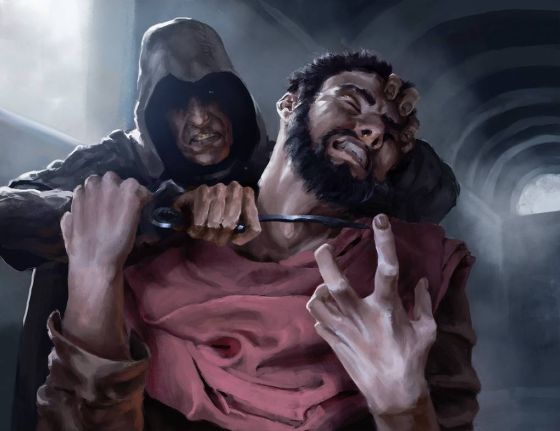Assassination (sage ability)
Assassination is an amateur-status sage ability in the study of Murder that functions as a form of attack in which the character is able to potentially dispatch the defender with little difficulty. In effect, a weapon is used to strike at a weak point in the victim, bringing about death.
Contents
The sage ability is, to a lesser degree, available to assassins who possess less than 10 points of knowledge in murder, on account of their class. In such cases, the practice is termed unskilled assassination, distinguishing it as less effective than attacks make with amateur or greater skill.
Opportunity
Before assassination can be committed, the character first surprise the intended victim, coming upon them in a manner that makes surprise possible. Additionally, the would-be assassin must be near enough to the victim to take advantage of the surprise when it occurs, before initiative is necessary. Creating this opportunity is up to the player's choices in describing the character's actions prior to the attack.
Approach is usually accomplished through stealth, regardless of the character's skill in this ability.
Assassination Attempt
Once the element of surprise and proximity has been achieved, the assailant proceeds to make a standard roll to hit using any hand-to-hand weapon at their disposal.
Skilled Assassination
When the dice indicate a successful hit, a skilled assassin then rolls 2d4, adds their own [[Experience Level|experience level]=], and subtracts 5 points from the result. If the final total equals or surpasses the combined total of the victim's hit dice and experience levels, the target is is absolutely dead, beyond any doubt.
- For example, a 7th level skilled assassin, Maria, successfully surprises Theodore, a 5th level character. Rolling, she manages to hit Theodore's armour class. Rolling 2d4, she obtains a result of "4," then adds her level for a total of 11. After subtracting 5, she arrives at a final score of "6." This figure matches Theodore's level, plus an additional hit die for his mass, resulting in a successful assassination. Theodore is dead.
Based on this calculation, Maria would have a guaranteed chance of killing any character whose level is at least 4 levels lower than hers, once she achieves surprise. In her encounter with Theodore, her odds of success were 13 in 16; had Theodore been one level lower, her chances would have increased to 15 in 16.
Unskilled Assassins
Assassins lacking the sage ability employ a similar method to resolve assassinations, except that their level bonus is reduced to a mere ½ point per level. In the aforementioned example, Maria would add 3 to her 2d4 die roll, discarding any fractions. This adjustment would have resulted in a failed assassination attempt.
Failed Assassinations
If the assassination attempt falls short, standard damage for the weapon is rolled. If the defender is not stunned, both the defender and the failed assassin proceed to roll for initiative, like any other combat situation that follows a surprise attack. Subsequently, the combat unfolds as per standard combat rules. A second assassination attempt cannot be made, as the defender can no longer be caught by surprise.
Notes
An assassination cannot take place during melee, as according to the rules discussing the surprise of opponents, the defender cannot be aware of the assassin's existence. This is plainly not possible if the defender and assassin are in combat.
Victims of assassination may be restored through the death's door spell.
Regarding the possible assassination of very large creatures, such as giants, if the intended victim is thrice the height of the would-be assassin, or has more than four times the assassin's weight, the victim is too large to be assassinated.
See Also,
Assassin
Murder
Player Characters
